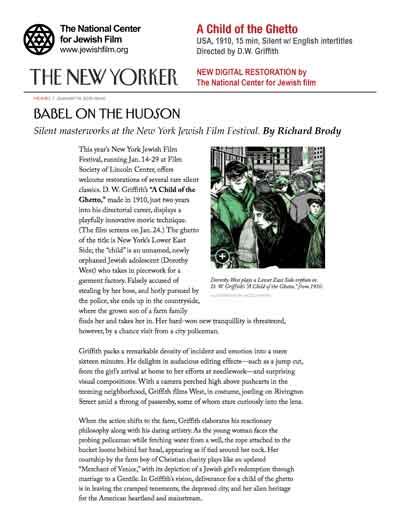A Child of the Ghetto USA, 1910, 15 minutes New Score by Swedish Composers
Questions about this title for Home or Classroom/ Library Use? Please email us at ncjf(at)jewishfilm(dot)edu Arrange a Screening Contact us at jewishfilm(at)brandeis(dot)edu Public Exhibition Formats: Blu-ray, DVD |
|
"Rivington Street was the lively one, eternally jammed with pushcart peddlers hawking their wares. They had every imaginable commodity, from a needle to a wedding outfit... Emotional, tempestuous, harrowing Rivington Street was perpetually a steaming, bubbling pot of human flesh."
- D.W. Griffith
Video: Live Performance at Stockholm JFF 2012
![]()
Downloads
![]()

Babel on the Hudson: Silent masterworks at the New York Jewish Film Festival The New Yorker (Jan. 19, 2015)
Synopsis
![]()
This short tale of Lower East Side life captures the hustle and bustle of Rivington Street through the lens of legendary Hollywood director D.W. Griffith. After the death of her mother, Ruth struggles to support herself as a seamstress. As she delivers her bundle of shirts to the factory owner, the owner's son steals some money and Ruth is accused of the crime. She then flees the ghetto and hides in the country where a young farmer takes her in and they fall in love.
A Child of the Ghetto was made at the height of Griffith's career at Biograph, a period when he was perfecting the storytelling power of the film medium. Like Romance of a Jewess, this is a story of Lower East Side life, and Griffith again captures in near-documentary style the hustle and bustle of Rivington Street. Griffith's development of editing techniques since 1908 is evident; although both films are about the same length, A Child of the Ghetto has forty-six shots while Romance of a Jewess has only thriteen!
The movement from city slums to pastoral country differentiates A Child of the Ghetto from most other American Jewish films of this period. The city is seen as a place of hardship, exploitation, and false accusation, while the country offers health, trust, beauty, and love. Griffith seems to indicate that immigrant Jews would improve their lives by moving out of the ghetto, a possibility entertained by few other films. A Child of the Ghetto is also one of the earliest films to treat an interfaith romance unproblematically.
Selected Screenings
![]()
![]() 4th Jewish Culture Festival - Gdansk, Poland (2016)
4th Jewish Culture Festival - Gdansk, Poland (2016)
![]() Maine Jewish Film Festival/Friends of the Kotzschmar Organ, with live accompaniment (2015)
Maine Jewish Film Festival/Friends of the Kotzschmar Organ, with live accompaniment (2015)
![]() New York Jewish Film Festival, with live accompaniment (January 2015)
New York Jewish Film Festival, with live accompaniment (January 2015)
![]() World Premiere of New Digital Restoration NCJF's 17th Annual Film Festival
World Premiere of New Digital Restoration NCJF's 17th Annual Film Festival
![]() Jewish Museum Prague (2013)
Jewish Museum Prague (2013)
![]() Stockholm Jewish Film Festival (2012)
Stockholm Jewish Film Festival (2012)
NCJF Digital Film Restoration
![]()
Special Thanks to Massachusetts Cultural Council, Brandeis University, Stockholm Jewish Film Festival, Dan Grandér, Tom Gunning
2014 Digital Restoration © The National Center for Jewish Film
Executive Director Sharon Pucker Rivo
Co-Director Lisa Rivo
Technical Director Rich Pontius
Intern Sam Bender
Film Transfer Colorlab
Post Production Modulus Studios
Credits
![]()
Director D.W. Griffith
Photographer Billy Blitzer
Cast
Dorothy West (Ruth)
George Nichols (Officer Quinn)
Henry Walthall (Farmer)
Music
![]()
New original score by Swedish musicians Alexander Freudenthal & Hans Nyman recorded in Stockholm.
Emma Lindhamre Cello
Alexander Freudenthal Bass clarinet & clarinet in Bb
Hans Nyman Baritone guitar & zither
Pär Jaktelius Percussion
Recorded & mixed by Stefan Levin
Original score ©2012 Alexander Freudenthal & Hans Nyman
![]()







